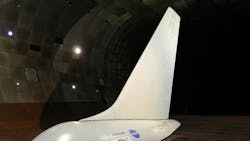Military researchers consider new active flow control to eliminate control surfaces on military aircraft
ARLINGTON, Va. – U.S. military researchers are trying to push the bounds of future electric aircraft by eliminating control surfaces like ailerons, rudders, and flaps, and instead using actuators or effectors to add energy or momentum to the flow of air over the aircraft.
Officials of the U.S. Defense Advanced Research Projects Agency (DARPA) in Arlington, Va., issued a broad agency announcement on Monday (HR001119S0072) for the Control of Revolutionary Aircraft with Novel Effectors (CRANE) project.
CRANE seeks to inject a disruptive technology early in aircraft design with new flow-control technologies and design tools. The idea is to configure and optimize an aircraft with active flow control to enhance efficiency and effectiveness of new commercial and military aircraft.
Passive control involves geometrical modifications like vortex generators on an aircraft wing for flow separation control, or chevrons on an exhaust nozzle of an aircraft to mitigate noise. Passive control devices always are on, no matter the need or performance penalty.
Related: BAE will supply digital electronic engine control for F-35
Active flow control, on the other hand, involves energy or momentum addition to the flow in a regulated manner. It is more desirable than passive control because aircraft pilots can turn it on or off as necessary.
Active flow control alters the aircraft's aerodynamic flow field through mechanical actuators, or by ejection or suction on a wing, fuselage, inlet, or nozzle.
Effectors and actuators typically are the enabling technologies of active flow control, yet have been the weakest link in developing active flow-control technology. Despite their relatively high costs, effectors and actuators typically are light weight, have no moving parts, and are energy-efficient.
DARPA officials say they would like to demonstrate new active flow control on an X-plane, yet are encouraging proposers to focus on the best ways to develop and flight demonstrate their flow-control technologies on a clean-sheet design or modification of an existing aircraft. DARPA expects substantial use of off-the-shelf components, especially for items unrelated to the active flow control subsystems.
The CRANE project excludes large external moving surfaces like ailerons, rudders, flaps, elevators, and trim surfaces; mechanical vectoring of engine jet exhaust, or other traditional moving aerodynamic control devices.
CRANE's goal is to demonstrate in flight that active flow-control actuator technologies can maintain flight safely, and provide quantifiable aircraft capabilities.
The program is a four-phase developmental cycle with each phase building on the previous phase. Phase 0 focuses on the design process and maturing understanding through configuration agnostic-designs, geometric and technology trade studies, and process documentation.
Related: Navy pushes shipboard unmanned systems, lethality upgrades
Phase 1 will validate analytical predictions, control loop analyses, and modeling verification. The remaining two phases may involve a limited competition among Phase 1 performers. Phase 2 would test integrated subsystem component, and phase 3 would include fabrication, assembly, ground test, and flight demonstration.
Companies interested should submit proposals to the DARPA BAA Website no later than 8 Nov. 2019 at https://baa.darpa.mil. Email questions or concerns to DARPA at [email protected].
More information is online at http://www.fbodaily.com/archive/2019/08-August/14-Aug-2019/FBO-05401240.htm.
About the Author
John Keller
Editor-in-Chief
John Keller is the Editor-in-Chief, Military & Aerospace Electronics Magazine--provides extensive coverage and analysis of enabling electronics and optoelectronic technologies in military, space and commercial aviation applications. John has been a member of the Military & Aerospace Electronics staff since 1989 and chief editor since 1995.
